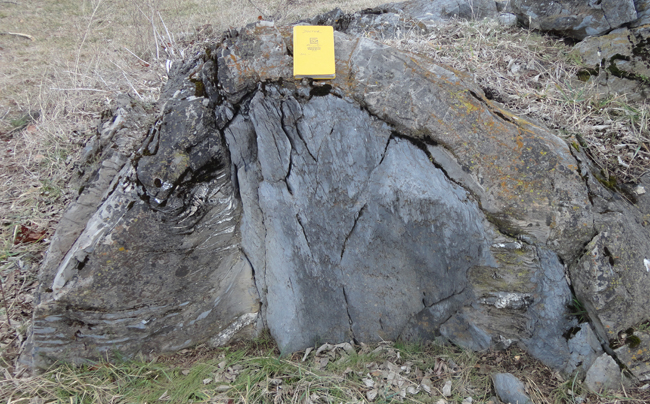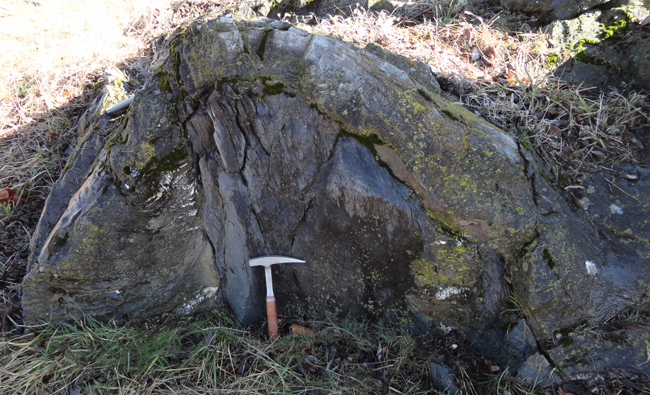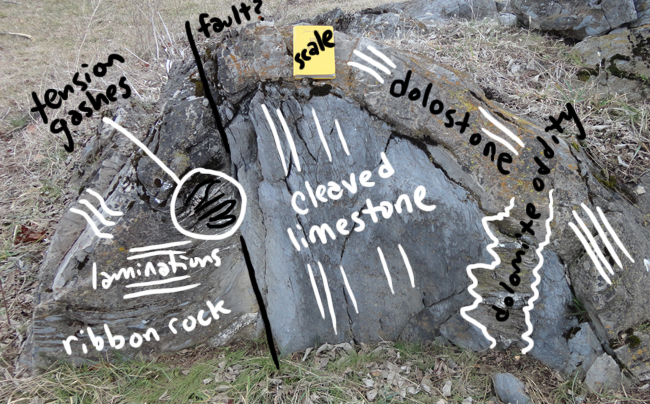This weird fold is exposed on private farmland in the Boyce quadrangle of Virginia. It’s the Conococheague Formation, a Cambrian limestone/dolostone package that records shallow tropical marine conditions, a passive margin setting.

I visited it Wednesday, twice. Dan Doctor (USGS) and Alan Pitts (USGS/University of Camerino, Italy) took me there in the morning, when it was in partial sun and partial shade, and partly wet and partly dry – not ideal for photography. Here’s what it looked like then:

So we went on to other sites and then returned at day’s end to view it again. It was amazing to see how different it looked – structures unseen in the morning were painfully obvious in the evening. Here’s a handful of them…

It’s a fold… but an odd one. The thickness of the dolostone layer strikes me as particularly odd – if folded sedimentary layers aren’t uniformly thick (concentric folds), then usually what happens is the hinge area of the fold is thickened, and the limbs are thinned. That appears to be the opposite of what this fold shows. Not only that, but the laminations within the dolostone are horizontal where I would expect them to be vertical. Yet the cleavage suggests the fold is upright, but then the trend of the fold axis appears non-parallel to the cleavage plane. It’s off by 30° or so! What’s more: Is the left side of this fold a fault? The tension gashes there certainly suggest it has been elongated in a semi-brittle fashion in a vertical direction.
And what about that odd horizontally-barred “seam” of dolomite that cuts vertically through the right side of the fold? What … is … that?? A clastic dike? A zone of secondary dolomitization (non-depositional, but diagenetic instead) that formed adjacent to some vertical fracture?
Alan was good enough to shoot a GigaPan of it in the crepuscular gloaming:
Not only that, but today I’ve got another kind of interactive image to share: A photosynth that Dan shot. You can spin it around and get a sense of the three-dimensional shape of this outcrop:
Happy Friday to all!

Weird is right! From these photos, I can’t shake the feeling that the bluish limestone is badly out of place. I don’t know the broader setting, but could that hunk of limestone be an olistolith? If so, it would be consistent with the weird angles, and some (if not all) of the folding might be consistent with soft-sediment deformation as the sediment that eventually became the dolostone was squished around the block. It might also explain the “clastic dike”, if the “olistolith” was broken as it fell into place, allowing the dolostone sediment to fill the gap. Also, the apparent thinning on the “fold” axis might be consistent with soft (or semi-consolidated) sediment being squished around the pointy end of an olistolith.
Or do I need to give my head a shake? 😉
–Howard
The Concocheague consists of alternating layers of limestone and dolostone – it’s entirely expected to see them stacked atop one another like this. Thanks for your thoughts!
I’ve seen some similar oddities in other limestone/dolomite formations in the Shenandoah Valley where the fold in the rock doesn’t seem to follow the fold axis in the geologic map. My guess is that the tip of a limb first lunged forward and then curled around inward like a snail shell when the rock movement was suddenly stopped by a collision. That might explain the change in lamination/cleavage from horizontal in the dolostone to angled in the ribbon rock and finally vertical in the limestone.